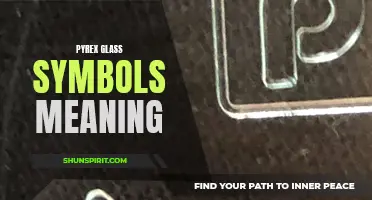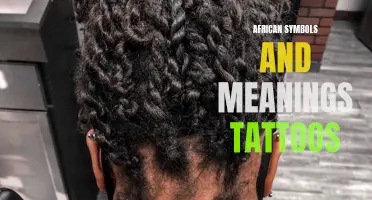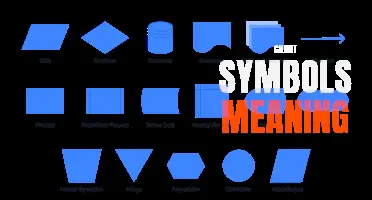
The Huichol people, an indigenous group from Mexico, have a vibrant and ancient culture filled with rich symbolism and meaningful traditions. At the heart of their belief system are the Huichol symbols and their deep spiritual meanings. These symbols, often depicted through colorful beadwork and weaving, serve as a visual language that communicate their connection to the natural world, their ancestors, and the divine. In this article, we will explore some of the most captivating Huichol symbols and delve into their profound significance in Huichol spirituality and everyday life.
What You'll Learn
- What are some common Huichol symbols and their meanings?
- How do the Huichol use symbols in their artwork and religious ceremonies?
- Are there any specific symbols that are considered sacred or have a deeper spiritual significance in Huichol culture?
- What are the traditional or historical origins of Huichol symbols and meanings?
- How have Huichol symbols and meanings evolved or adapted over time?

What are some common Huichol symbols and their meanings?
The Huichol people are an indigenous group that resides in the western central part of Mexico. They have a rich cultural heritage and are known for their intricate artwork and spiritual practices. Among the most notable aspects of Huichol culture are their use of symbols, which hold deep meanings and significance. Here are some common Huichol symbols and their meanings:
- The Peyote: The peyote plant is central to Huichol spirituality. It is considered a powerful medicine and is used in their religious ceremonies. The peyote symbol represents spiritual enlightenment, wisdom, and the connection to the divine.
- The Deer: The deer is a sacred animal to the Huichol people and is believed to be a messenger between the spiritual and physical worlds. The deer symbolizes agility, grace, and power, and is often associated with good fortune and protection.
- The Serpent: The serpent is another significant symbol in Huichol culture. It represents transformation, healing, and the cyclical nature of life. The serpent is believed to have the power to shed its skin and be reborn, symbolizing the Huichol belief in the cycle of life and death.
- The Eagle: The eagle is a symbol of strength, courage, and vision. It is associated with the sun and the heavens, and is often seen as a protector and guide. The eagle represents a connection between the earthly and divine realms.
- The Nierika: The Nierika is a symbolic doorway or portal that allows communication between the spiritual and physical realms. It is often depicted as a circular or diamond-shaped design and is used in Huichol art to create a connection with the divine.
- The Corn: Corn holds great importance in Huichol culture as it is seen as a gift from the gods. It symbolizes sustenance, fertility, and abundance. Corn is often represented in Huichol art in various forms, such as ears of corn or corn kernels.
- The Sun and Moon: The sun and moon are seen as celestial beings in Huichol culture. The sun represents masculine energy, vitality, and life, while the moon represents feminine energy, intuition, and receptivity. Together, they symbolize balance and harmony.
These symbols are intricately woven into Huichol artwork, such as yarn paintings, beadwork, and sculptures. Each symbol conveys a specific meaning that is deeply rooted in Huichol spirituality and worldview. By using these symbols, the Huichol people not only express their artistic creativity but also connect with their ancient cultural heritage and spiritual beliefs.
Decoding the Symbols and Meanings of Caterpillar Heavy Equipment
You may want to see also

How do the Huichol use symbols in their artwork and religious ceremonies?
The Huichol, also known as the Wixaritari, are an indigenous people living in the Sierra Madre Occidental mountain range in Mexico. They have a rich cultural heritage that is deeply intertwined with their art and religious ceremonies. Symbols play a vital role in their artwork and are used to convey spiritual and ancestral knowledge.
The Huichol have a unique artistic tradition that has been passed down through generations. Their artwork is characterized by vibrant colors and intricate designs, often featuring symbols that hold deep spiritual meaning. One of the most prominent symbols in Huichol art is the peyote, a small cactus that is central to their religious ceremonies. The peyote is believed to connect humans with the divine and is revered as a spiritual guide. It is commonly depicted in their artwork as a sacred symbol of wisdom and enlightenment.
Other symbols commonly found in Huichol art include the deer, eagle, snake, and corn. Each of these symbols carries its own significance and represents different aspects of the Huichol cosmology. For example, the deer is believed to be a messenger between the human and spirit worlds, while the eagle represents spiritual insight and protection. The snake is seen as a symbol of transformation and rebirth, and corn symbolizes fertility and abundance.
These symbols are not only used in their artwork but also play a central role in Huichol religious ceremonies. The Huichol have a complex and deeply spiritual belief system that revolves around the worship of their deities and ancestors. During ceremonies, symbols such as the peyote, deer, and eagle are used to represent these spiritual beings and invoke their presence.
In Huichol religious ceremonies known as "mitote," participants consume peyote and enter into a trance-like state to communicate with the divine. The use of symbols during these ceremonies helps to create a connection between the physical and spiritual worlds, allowing participants to access higher states of consciousness. Symbolic objects such as beaded prayer bowls and yarn paintings, adorned with various symbols, are also used in these ceremonies as offerings to the deities.
The Huichol believe that their artwork and religious ceremonies are interconnected, as the symbols used in their art represent the same spiritual forces that are invoked in their ceremonies. Through their artwork, the Huichol aim to preserve their cultural traditions and pass on their spiritual knowledge to future generations. It is through the use of symbols that they are able to communicate and transmit their spiritual beliefs and experiences.
In conclusion, symbols play a significant role in both the artwork and religious ceremonies of the Huichol people. These symbols convey spiritual and ancestral knowledge and help to connect the Huichol with the divine. Through their art and ceremonies, the Huichol aim to preserve their cultural traditions and pass on their spiritual teachings, ensuring that their unique heritage endures for generations to come.
Decoding the Bobcat Warning Light Symbols: Understand Their Meanings
You may want to see also

Are there any specific symbols that are considered sacred or have a deeper spiritual significance in Huichol culture?
Huichol culture is characterized by its deep spirituality and traditional beliefs. The Huichol people have a rich symbolic language that is used to express their connection to the divine and the natural world. This article will explore some of the specific symbols that are considered sacred or have a deeper spiritual significance in Huichol culture.
One of the most important symbols in Huichol culture is the peyote cactus. Peyote is a sacred plant that is used in religious ceremonies and is believed to have the power to connect people with the spirit world. The Huichol people have a long tradition of using peyote as a tool for spiritual awakening and healing. The peyote symbol is often depicted in Huichol art and is considered a powerful and sacred symbol.
Another significant symbol in Huichol culture is the deer. The deer is seen as a messenger from the spirit world and is believed to possess spiritual wisdom and guidance. The Huichol people believe that the deer has the power to connect the physical and spiritual realms, and they often incorporate deer imagery in their artwork and rituals.
The Huichol people also attribute great importance to the eagle symbol. The eagle is believed to be a powerful and sacred bird that carries messages between the heavens and the earth. In Huichol culture, the eagle symbol represents the freedom of the soul and is often associated with spiritual guidance and protection.
The Huichol people have a deep reverence for the sun. They believe that the sun is both a physical and spiritual source of life and energy. The sun symbol is often depicted in Huichol art and is considered a powerful symbol of vitality, power, and spiritual energy.
The serpent is another important symbol in Huichol culture. The serpent is seen as a symbol of transformation and rebirth and is believed to possess great spiritual power. The serpent symbol is often incorporated in Huichol artwork and is seen as a guardian and protector.
The above symbols are just a few examples of the sacred and spiritually significant symbols in Huichol culture. Each symbol carries its own unique meaning and is used to convey a deeper understanding of the world and the connection between the physical and spiritual realms. These symbols are not only visually appealing but also carry a deeper spiritual significance that is deeply ingrained in the Huichol people's beliefs and traditions.
Decoding Caterpillar Warning Symbols: What Do They Mean and How to Respond
You may want to see also

What are the traditional or historical origins of Huichol symbols and meanings?
The Huichol people, also known as the Wixáritari, are an indigenous group from the western part of Mexico, primarily residing in the states of Nayarit, Jalisco, Zacatecas, and Durango. They have a rich cultural heritage that is deeply rooted in their spiritual beliefs and rituals. One of the most distinctive aspects of Huichol culture is their use of symbols and their associated meanings.
The origins of Huichol symbols can be traced back to pre-Columbian times and are closely tied to their religious practices. The Huichol believe in the existence of multiple deities and spirits that govern different aspects of life, such as the sun, moon, rain, and animals. They use symbols as a way to communicate and connect with these divine entities.
One of the most common symbols in Huichol art is the "peyote," which holds great significance in their religious ceremonies. Peyote is a small cactus that contains a psychoactive substance called mescaline, and it is believed to allow contact with the spiritual realm. The Huichol use peyote as a tool for spiritual journeying and healing, and it is frequently depicted in their artwork.
Another prevalent symbol in Huichol art is the "deer," which is considered a sacred animal and a messenger between the divine and human realms. The deer represents wisdom, grace, and abundance, and it is often depicted in vibrant colors and intricate patterns. The Huichol use the image of the deer as a symbol of protection and guidance.
Other commonly used symbols in Huichol art include the "sun," which is associated with light, warmth, and fertility, and the "rattlesnake," which symbolizes transformation and rebirth. These symbols are often incorporated into beaded jewelry, yarn paintings, and wooden sculptures, which are integral parts of Huichol artistry.
Huichol symbols and their associated meanings are passed down through generations orally and through artistic traditions. The symbols are carefully preserved and used in various ceremonies, including the pilgrimage to Wirikuta, a sacred site where the Huichol believe their spiritual journey begins.
In recent years, Huichol art has gained recognition and popularity outside of the indigenous community. Their vibrant and intricate designs have been featured in international exhibitions, enabling a wider audience to appreciate and understand the cultural significance of Huichol symbols.
In conclusion, the traditional origins of Huichol symbols and their meanings can be traced back to pre-Columbian times. These symbols are deeply rooted in the religious practices of the Huichol people and are used to communicate with the divine. The symbols, such as the peyote, deer, sun, and rattlesnake, are passed down through generations and play a crucial role in Huichol art and rituals. Their intricate designs and vibrant colors showcase the rich cultural heritage of the Huichol people and serve as a medium for preserving and sharing their traditions with the world.
The Symbolic Meaning Behind Flickering Lights and What It Signifies
You may want to see also

How have Huichol symbols and meanings evolved or adapted over time?
Huichol symbols and their meanings have a rich and complex history that has evolved and adapted over time. The Huichol people, also known as the Wixárika, are an indigenous group native to the states of Jalisco, Nayarit, Durango, and Zacatecas in Mexico. They have a deep spiritual connection with the natural world and their symbols are a reflection of their beliefs, traditions, and cultural heritage.
The symbols used by the Huichol people are often representations of the natural elements such as animals, plants, and celestial bodies. They are also used to convey spiritual concepts and express the Huichol worldview. For example, the deer is a symbol of protection and abundance, while the peyote cactus represents enlightenment and the connection between the spiritual and physical worlds.
Over time, these symbols have undergone changes and adaptations as the Huichol people have interacted with other cultures and faced social and environmental changes. The influence of the Spanish colonization of Mexico and the introduction of Christianity have had a significant impact on Huichol symbolism. Some traditional symbols have merged with Christian imagery, resulting in a unique blend of indigenous and Catholic symbolism.
Another factor that has influenced the evolution of Huichol symbols is the ongoing modernization and globalization. As the Huichol people have become more connected to the world beyond their communities, they have had to adapt their symbols to appeal to a wider audience and accommodate new ideas and perspectives. This has led to the emergence of new symbols and the reinterpretation of traditional ones.
Despite these changes, the core meanings and significance of Huichol symbols have remained intact. They continue to serve as a means of cultural preservation and identity for the Huichol people. The symbols are used in various forms of Huichol art, such as beadwork, yarn painting, and embroidery, and are often incorporated into ceremonial practices and rituals.
In recent years, there has been a resurgence of interest in Huichol symbolism and art among both the indigenous Huichol community and the wider world. This renewed appreciation has led to a revitalization of traditional practices and a renewed focus on preserving and passing on the cultural knowledge associated with Huichol symbols.
Overall, the evolution and adaptation of Huichol symbols and their meanings over time reflect the dynamic nature of indigenous cultures and their ability to adapt and respond to changing circumstances. The Huichol people's commitment to keeping their traditions alive while embracing new ideas and perspectives ensures that their symbols continue to be a vibrant and relevant expression of their cultural heritage.
Frequently asked questions
Some of the most common symbols in Huichol art include the Peyote cactus, which represents spiritual enlightenment and guidance; the deer, which symbolizes peace and harmony with nature; and the yarn or thread, which represents the interconnectedness of all things. These symbols often appear in intricate and colorful patterns in Huichol beadwork and yarn paintings.
Symbols play a significant role in Huichol spirituality and cultural practices. They are used to communicate with the spiritual realm, invoke protection and guidance from ancestors and deities, and reinforce the interconnectedness of all living beings. By creating intricate artworks with these symbols, the Huichol express their devotion and respect for their traditions.
While some Huichol symbols have specific meanings known only to the Huichol people, many symbols can be interpreted by outsiders based on their cultural context and common associations. However, it is important to approach these symbols with respect and cultural sensitivity, as their meanings may differ from those in Western culture.
Huichol symbols are primarily passed down through oral tradition and practical teachings within the community. Elders and spiritual leaders share their knowledge and wisdom with younger generations, ensuring the continuity of these symbols and their meanings. Additionally, the creation and use of Huichol art forms, such as beadwork and yarn paintings, serve as visual reminders and repositories of these symbols and their significance.
Yes, Huichol symbols are still relevant in modern times. They are a vital part of Huichol identity, spirituality, and cultural practices. Additionally, the creation and sale of Huichol art, which prominently feature these symbols, provide economic opportunities for Huichol artisans and contribute to the preservation and appreciation of their rich cultural heritage.







